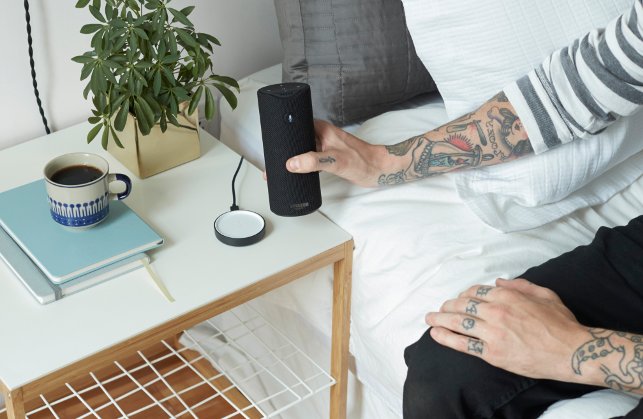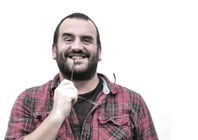The rise of the connected device holds rich potential — not just in making new things but for enriching the lives and welfare of those that need help the most, thinks Al Dean. He also thinks it’ll help save those ‘family tech support’ calls

One of Amazon’s press images for the Tap device (a wireless version of the Echo not yet in European stores). Flash card tattoos, a Breton stripe top, minimalist furniture, Moleskine notebooks on the night-stand — Amazon are clearly shooting for a specific demographic (even if the coffee cup is awful)
I think we can all agree that the age of the connected device is well and truly here. Just this week, I sat down to watch a prime time TV show that looked at Amazon’s Echo device and its potential for assisting the older generation in our communities. Not least of all by providing a little bit of vaguely human interaction for those spending huge swathes of their weeks alone.
This short segment on the BBC showed that, while product design is often focussed on the younger end of the spectrum and certainly those segments of our communities with enough disposable cash to spend on new technology, we’re often missing a trick.
All too often the technology industry focusses on the needs of its key demographics (for very good reason), but with a little thought they’d realise that not everyone knows how to use a computer, how to connect a bluetooth device or to even get as far as knowing where to start with those god awful ‘quick set-up’ instruction sheets.
A prime example is what we’ve come to refer to in the office as the “informal technical support service”. It’s that point in the festive proceedings when you get the inevitable phone call or someone pitches up on your door step with a variety of electronic devices in hand and a mournful look on their face.
Yup. Your parents, your in-laws, your aunt, your neighbour or someone you once met in the pub, has bought themselves the latest gadget and has no idea what to do with it. And because you “work in computers”, you’re just the person to help them. A situation familiar to many, I’m sure.
Whether it’s a new printer, a new phone (with the buttons far too small for the granny with early stage glaucoma) or any manner of gadgetry.
They place it into your hands like their first born and utter the words you dread to hear — “I don’t know how to connect it to my internet” (never mind the fact that ‘their internet’ is four miles away).
This might come across as flippant and a little disrespectful of those that aren’t as tech savvy as the average D3D reader (not that any of you are, by any means, average) but there’s some truth here.
Today, we’re surrounded by a miasma of technology that’s often far outstripping any of its practical use. Just recently, I was ‘helping’ set-up a TV for a couple in their early sixties.
The user interface for the TV was bad enough, but there wasn’t a single button readily accessible anywhere on the device.
If the remote got lost, the huge jumbotron of a TV simply would not be able to function and would effectively become a very expensive blackboard mounted above a fireplace.
Never mind the fact it is a smart TV that allows you to connect wirelessly to a laptop, enabling you to check email on it or use any number of the built-in internet streaming services. The simple fact that the overly complex remote control (don’t get me started on those) went for walkabout for a couple of days, meant they had no way of watching Antiques Road Trip with their afternoon brew.
Forget Netflix and Chill, if you can’t watch someone spending 200 quid on a collection of tat for resale with your afternoon cup of tea, what is the bloody point?
As designers and engineers, we’re constantly under pressure to deliver more, faster and cheaper, but what about adding “and easier to use” to that holy trinity?
This year’s mantra should be (and repeat it after me) “I hereby promise to make shit easier to use, for everyone.” And by everyone, I mean not just those that know ‘pairing a bluetooth device’ doesn’t involve a trip to both the supermarket and the dentists
After all, we all like a product that’s easy to use. And by easy to use, it should be obvious and not require a master’s degree in computing and electronics to operate it.
It’s not good enough having a wireless speaker unit that not only understands the vagaries of human speech, but has access to the world’s information with a simple question.
All of this brought to mind the inevitable ‘just after New Year what should we be doing?’ thought process. After all, the new year marks the end of the old and beginning of a whole new 12 months in which we can create, develop and produce.
So I think year’s mantra should be (and repeat it after me) “I hereby promise to make shit easier to use, for everyone.” And by everyone, I mean not just those that know ‘pairing a bluetooth device’ doesn’t involve a trip to both the supermarket and the dentists.
Al Dean ponders the rise of the connected device and offers a mantra for designers
Default






